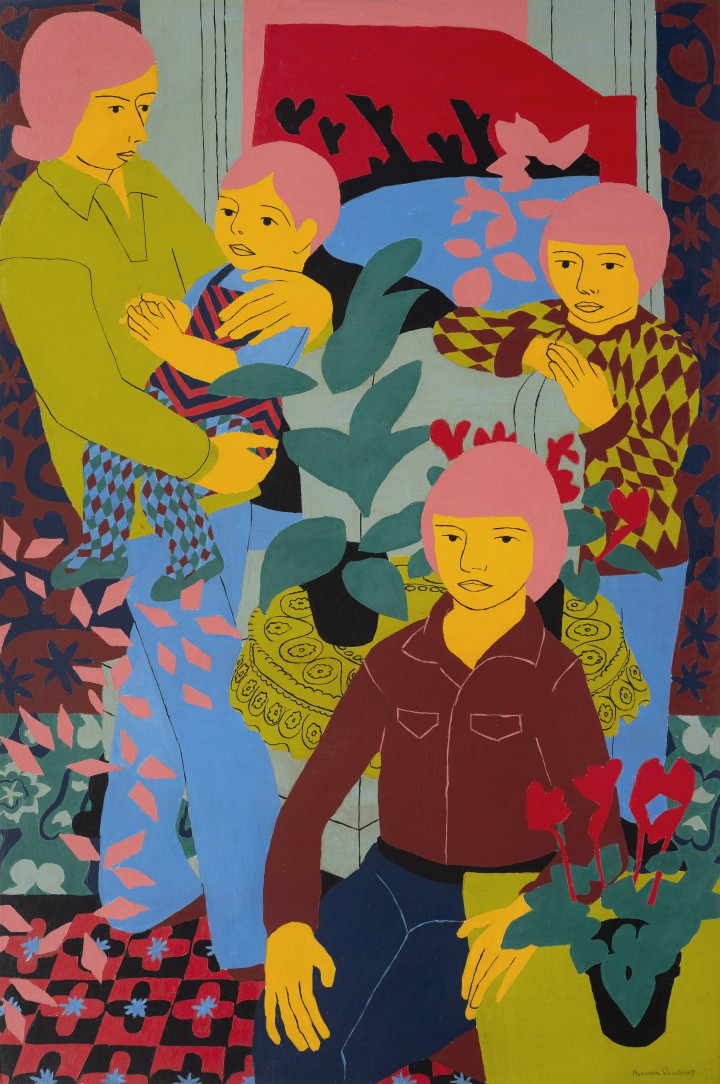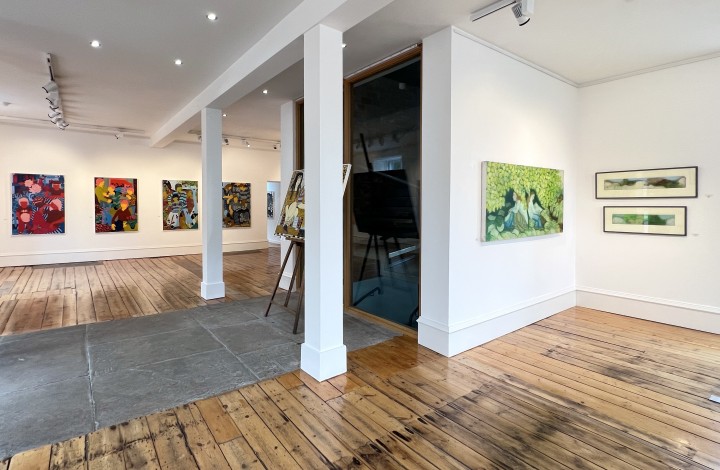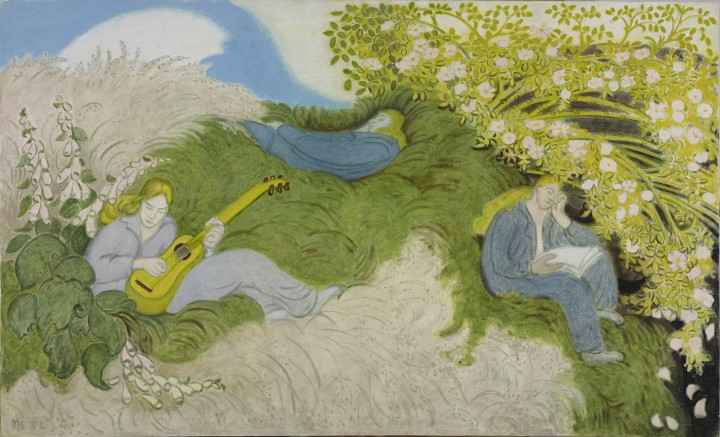Scottish Art News
Latest news
Magazine
News & Press
Publications
Norman Gilbert & Margot Sandeman: A Shared Passion
By Susan Mansfield, 10.11.2022

In Norman Gilbert’s studio, traces of the artist remain: the racks where he stacked his canvases, the wooden drawers which stored drawings. In this spacious first floor room - and, before that, in a similar room in the family’s previous flat - Gilbert painted for six decades. When he died in December 2019 at the age of 93, his last painting sat unfinished on the easel.
Now, his sons are gradually clearing the studio before the house is sold, and have formed a trust to look after their father’s artwork. They face the challenge of keeping public interest in his work alive in an art world which is often fixated with the new, and building the reputation of an artist who was overlooked for much of his llife.
Happily, this autumn, Gilbert’s work has been the subject of two exhibitions at the same time: a solo exhibition at Tramway, his first in Glasgow and first in a publicly funded gallery, and a two-person show at Tatha in Newport-on-Tay with the work of Margot Sandeman.
 Norman Gilbert & Margot Sandeman: A Shared Passion, at Tatha Gallery, Newport-on-Tay, ends November 12.
Norman Gilbert & Margot Sandeman: A Shared Passion, at Tatha Gallery, Newport-on-Tay, ends November 12.
Gilbert’s style is unmistakable, brightly coloured, highly decorative. Ever since he was shown the door at Glasgow School of Art in 1952 because he was considered “unteachable”, he pursued his own artistic path.
“Styles came and went and my father drove his own furrow straight through it,” says his son Bruno. “He was brave, he never stopped challenging himself, never stopped developing. If anyone asked him which painting was his favourite, he always said ‘the next one’. He was a true artist by my definition, he couldn’t not do it. It was his life.”
Gilbert’s paintings tell the family’s story. Working in the family home, he painted his sons as they grew up, their friends and girlfriends. Later, there were grandchildren, and always Norman’s wife Pat, who worked full-time as an art teacher to allow him to paint. He painted her, movingly, through her battle with dementia. After her death, he painted her empty chair.
There were moments when his career had seemed on the verge of a breakthrough: being included in a show at the prestigious Leicester Galleries in London in 1957; being the subject of a feature in Vogue in the 1960s; flying the family to London for an opening in Mayfair a decade later. Through highs and lows, however, he kept on painting.
He could not have imagined that his biggest breakthrough would come in his nineties. A short film for BBC’s digital platform Loop went viral and was watched seven million times worldwide. Gilbert went on to have two sell-out shows at Tatha and to remark, mildly, that he had sold more paintings in the last five years than he had in the previous 60.
When he died, he left behind some 309 oil paintings and more than 1500 drawings. While cataloguing and photographing, his family faces a balancing act: seeking to raise his profile by having exhibitions and selling work, but also holding back work which could potentially interest bigger collectors and public collections.
Bruno says: “We are not looking to make piles of money, we are looking to enhance his reputation and his legacy. He had aspirations that this was the direction of travel, he felt that his should be up there with the best of them. That’s our aspiration also.
“My fear is the momentum will peter out. And then how do we rebuild it?”
Jill Gerber, who runs Glasgow’s Compass Gallery, says an artist’s posthumous reputation depends, in large part, on commitment from the family. “In many cases, an artist just vanishes, like Bet Low, for example [a landscape painter who was one of the Glasgow Girls]. They vanish until many years later a gallery takes an interest and goes looking, but will they find enough work?
“The work has to be kept together and catalogued, that’s very important. You need that to carry on the legacy of what the artist has left behind. It takes the family to do that and to work with a gallery to keep an artist’s legacy alive.”
There are some striking parallels between Gilbert and Margot Sandeman, a near contemporary at Glasgow School of Art, who died in 2009. While her work was exhibited during her lifetime, and a painting was even aquired by the National Galleries of Scotland, arguably, she did not receive the attention she deserved.
While their styles were very different, Sandeman, too, painted her family, as well as landscapes and still lifes. Though it is not known if they ever met, both attended at Glasgow School of Art, were exhibited in Edinburgh by Richard Demarco, and were the subject of shows at the Talbot Rice Gallery.
Lindsay Bennett of Tatha Gallery, who organised the exhibition, A Shared Passion, said: “This is the first time we’ve shown two dead artists, but it’s important because they are so exceptionally talented. Even though they are very different painters, they have the same quality of work, and that shines through. I think they have a lot to teach young artists.”
 Margot Sandeman, Three Figures in a Landscape, 1982. Courtesy of Tatha Gallery.
Margot Sandeman, Three Figures in a Landscape, 1982. Courtesy of Tatha Gallery.
Sandeman was a contemporary and close friend of Joan Eardley at Glasgow School of Art, and, with Eardley, was singled out for special tuition on grounds of her ability. Jill Gerber, who is working with Sandeman’s family, says: “She has been overshadowed and is often described as ‘a friend of Joan Eardley’, but her work was very different. Her work is deeply poetic, very expressive, but the foundation of it is her beautiful draughtsmanship. Opportunities for female artists were limited at the time and she was overlooked, as many of them were.”
Sandeman’s sons Peter and David Robson are now the chief custodians of her legacy. They, too, are dealing with the contents of a studio, in their case in the family home in Bearsden, cataloguing and photographing some 300 paintings and a much larger number of drawings.
David Robson says: “Both Peter and I love Margot’s work, and didn’t want to dispose of it. We feel that she was under-recognised in her lifetime, that her position in the pantheon of Scottish artists needs to be supported and enhanced. So part of our desire is to help grow that reputation, to be faithful custodians.
“Strategy is too grand a word, but our thought has been to encourage her representation in some public collections, to help cement her reputation.”
Like Norman Gilbert, Sandeman painted every day, pursuing her own style even when it was considered unfashionable. David says: “We often felt that Margot ploughed her own furrow. She wasn’t a great self-publicist, and also didn’t align with a particular fashion or painting school, she developed very much her own style.
“It has been enjoyable going through her work, you can track her thinking, see the development of her ideas. Sometimes we see ourselves - we were handy models for her figurative work! There are lots of questions we would like to ask her but, of course, we can’t - so it has been quite poignant too.”
Norman Gilbert & Margot Sandeman: A Shared Passion, at Tatha Gallery, Newport-on-Tay, ends November 12. Norman Gilbert at Tramway runs until 5 February 2023. For more information on Gilbert’s work see www.normangilbert.com. Also find paintings by Sandeman in the Fleming Collection.




